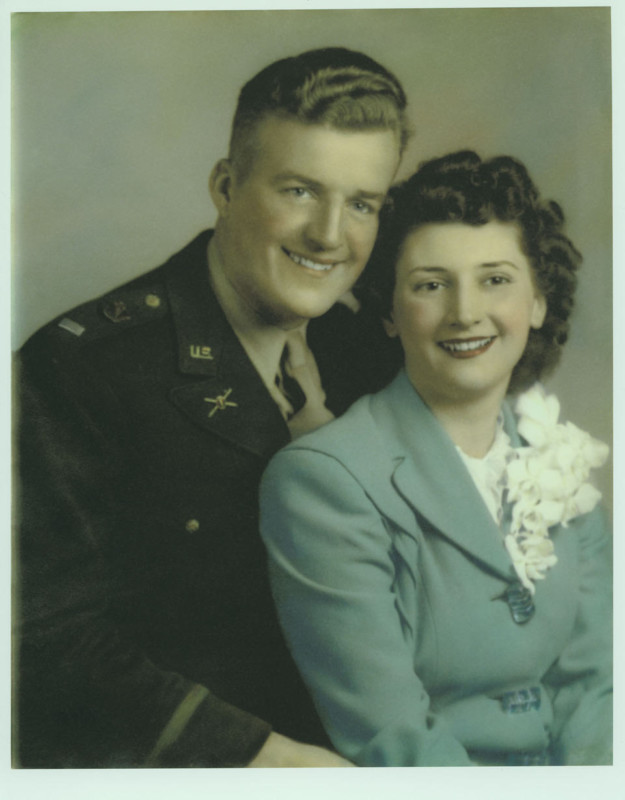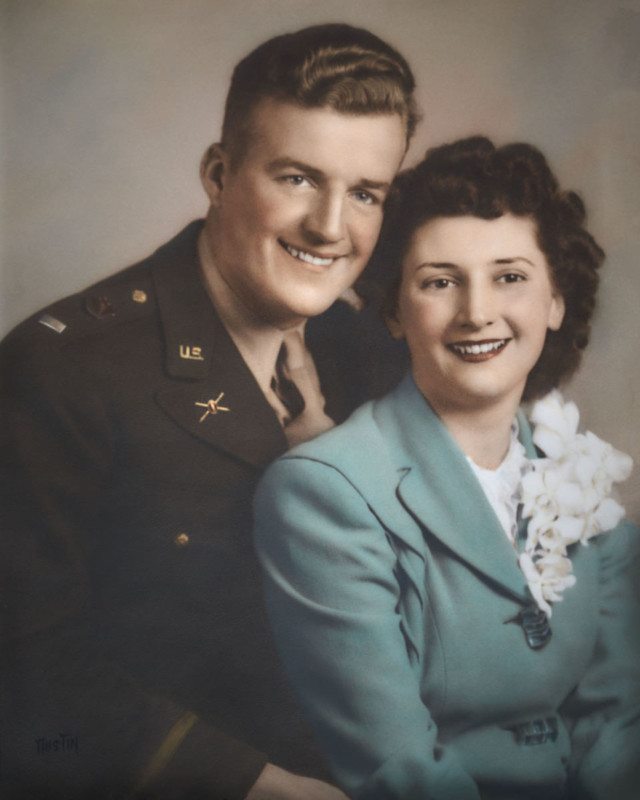Grandma and Grandpa’s Wedding Photo
![]()
It’s an odd day. After months of quarantine, this trip to the framer and lunch with my mother just filled me with so many emotions. It’s been over a year and I have finally “finished” the hardest project I have ever done. The priority mailboxes have been sent and the backing is on the frames. I feel as if I should rip them open and start all over. In my heart, I know I’ll never be completely satisfied or “finished”
He passed when I was in grade school but my early memories of him still guide me today. For my 48 years, grandma and grandpa’s wedding photo was an icon of where our family started. Of course, it predates my cousins, aunts, uncles, and my 73-year-old mom. It’s something we all grew up with and have memories of. No one can remember it being anywhere else except on top of grandpa’s dresser. We all have different memories tied to this photograph and oddly for me, it is always the image I think of when I think of them. Even though I never knew them at their age in the photo.
The original wedding photo is with her exactly where it is supposed to be: it was buried with my grandmother in 2018. She wanted to take it with her along with photos of her children, grandchildren, and great-grandchildren.
This, however, is not the original photo:
![]()
I had asked to copy the original almost 20 years ago. Back in the day when I was on the cutting edge with my brand new 6-megapixel camera and my Epson Photo 700 printer. It was the first “photo” printer with a black cartridge AND a five-color color cartridge — that’s right two separate cartridges, no color management, no profiles, and I printed it on one of the first “fine art papers,” Somerset Velvet.

I remember how it was a tough sell, my grandma was too smart to fall for my grandson charm so honesty, references, and a portfolio review eventually won her over. I remember the look of concern on my grandmother’s face when she agreed to let me photograph it. She was always very proud of me but my degree from photography school meant very little under these circumstances. I promised that I could do all the work in her home and assured her that I was trained to handle these situations.
With trembling hands and fear of the wooden spoon, I removed the backing and photograph as one piece from the frame. I took my best shots and carefully put it back together and brought it to the next room for my grandmother’s inspection that the photo was unharmed. I’m alive to tell this story today only because of my exceptional caution. Because of this exceptional caution, I didn’t notice the duplicate hand-colored copy behind the original.
Unbelievable, I know. While attending to my grandmothers’ final wishes, my uncle found a duplicate hand-colored copy behind the framed original. At the wake, he passed it along to me. Of course, It’s not mine, it’s the family’s photo. I am just the caretaker of this family icon. It is my responsibility to share this icon with the other family members and generations. But, as the family photographer, I had the opportunity to pass this icon on to everyone in the family.
I’m thinking a 42-megapixel full-frame camera should be able to do this only if paired with the top-rated macro lens. I’ll use the latest imaging software on a computer that is several generations advanced from the “computer” I used in my 6-megapixel heyday. Finally, I will print these with the latest inkjet technology, the richest, most lifelike ink set, and the most gorgeous fine art paper. And I will attempt this over and over and over for more than a year and I WILL NOT GET IT RIGHT.
I stress using emotions in printing and editing, and in this case, emotions just kept getting in the way. The color was spot on and I captured the texture of the original paper and each identical print one after the other had some flaw that needed to be corrected.
Then there was the issue with the European printer driver that nobody could figure out. That’s when my obsessive behavior kicked in and I printed over 100 variations on nine different papers from three manufactures. Technically I was sound but emotionally I wasn’t ready to work on this. My grandmother’s passing changed the meaning of this photograph, it was the last tie to so many memories, so it had to be perfect. I was torn between my memory as a grandson, my taste as a photographic artist, the 6-megapixel interpretation, and the similar duplicate that aged differently than the original.
![]()
I often hear that printing photographs isn’t worth the time, effort, or cost. I take several deep breaths, count to ten, think of bright sunny days and bunnies, then start to explain the importance of printing.
Since I’ve lectured on this topic several times, I will skip to one of my most painful parts:
I don’t have any children so my memories of my grandparents will be lost when I go. Along with my images stuck on unreadable hard drives and any outdated camera equipment I have left at the end, at best they will end up in some recycling center. I have an envelope of images I would like to bring with me but in reality, when I’m gone, that is it. The End.
Printing is our legacy.
Printing is how we remember while we’re here and how we hand down memories when we go. My grandmother didn’t want to be buried with a piece of paper, she wanted to be with that memory of my grandfather she had lost so many years before. It was only a piece of paper with silver halides and photo oils created by a photographer long gone.
Maybe the photographer noticed the uniform and thought “kid’s probably not going to be around by the time I’m done hand-coloring it.” If he didn’t print it, generations of children and grandchildren and great-grandchildren would never have seen the moment our family started. Grandma’s stories were always better when that picture was around.
So, when my uncle passed along the duplicate photo, he also passes along an incredible responsibility. I will never be happy with this image because of the finality of it however it is my most important work. I struggled with my memory of the original photo which I remember as brighter. The 6mp version is so primitive and possibly has shifted color over the years. The copy found behind the original has suffered from being exposed to non-archival materials and has aged differently. Finally, the biggest variable was me. How much of my photographic editing style do I let show?

My grandparents’ wedding photo has been the most challenging photograph I’ve ever printed. This version has several photographic influences behind it and subtly some of my own photographic personality. After all my obsessive testing, I used the Hahnemühle Photo Rag Baryta for my final prints. The paper’s warm glow feels like the memories of my grandparents I see in each family member’s faces.
Since I used the finest archival materials, these prints should be around for generations, so I printed one for my mom, my uncles, my cousins, and most importantly my cousin’s children since they are old enough to remember great-grandma.
I mailed the prints out and blamed the pandemic for not delivering them in person. I neglected to tell most everyone that I had been working on this, so it was a surprise when the prints were delivered. We chatted over the phone, but I left out the parts about the tears and my reasons why I felt we all needed a copy of the icon we all grew up with.
I hope they end up framed on their walls, but I can only provide the opportunity for memories. I had my mom’s print framed but luckily, we had to eat lunch in our separate cars when I delivered it. Sometimes we have to do things we are not ready for and sometimes we will never know the impact of what we have done.
Please print your images — you have no idea what they could mean to someone one day.
About the author: John Granata has a long 28 year storied history with photography and currently teaches printing classes at Richard Strongberg’s Chicago Photography Classes in Chicago, Illinois. The opinions expressed in this article are solely those of the authors. He presents a unique argument with an odd mix of technical and emotional reasons why printing is essential to every photographer and has a strong passion to create prints that speak to the viewer. Past projects include photographs taken and processed with that “John” look with several unique alternative printing methods and materials. He has a website that surely needs to be updated and possibly reworked. Currently, he is on hiatus from actively working photographically but is telling stories about past projects in order to rediscover his vision for new ones.